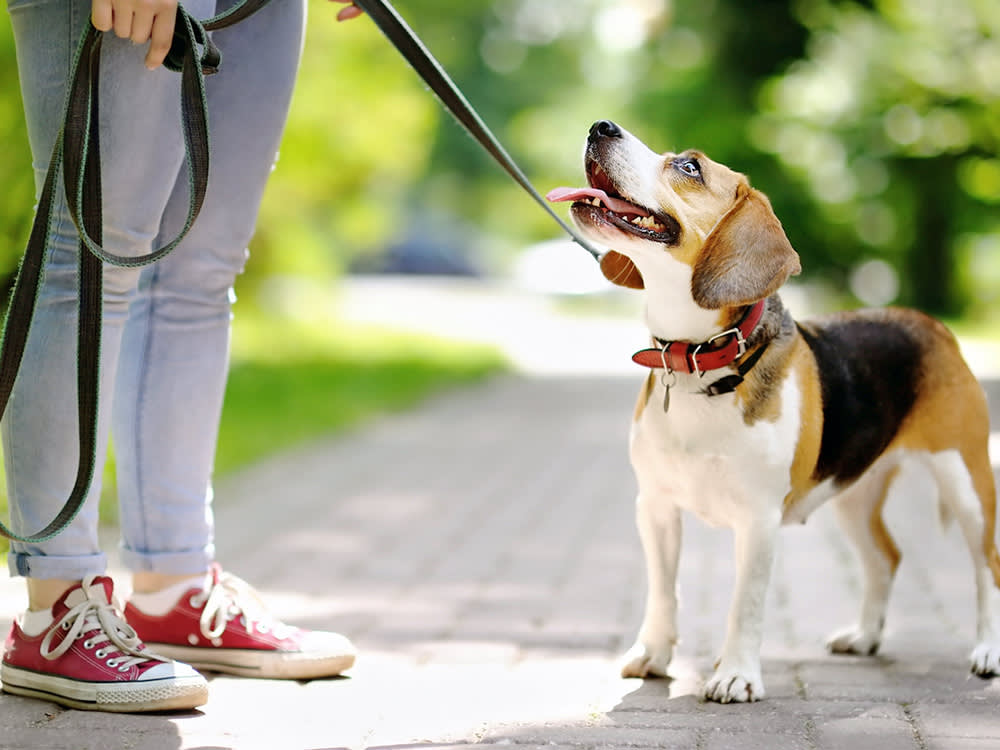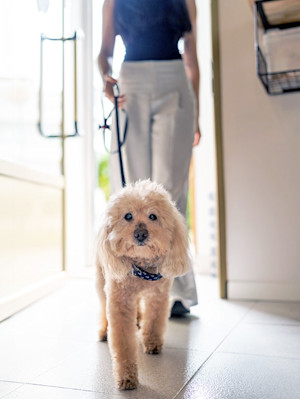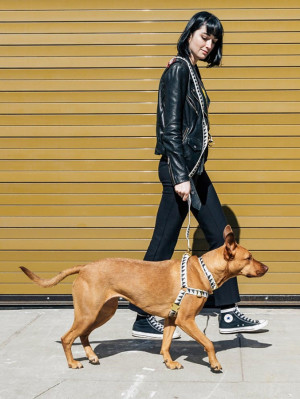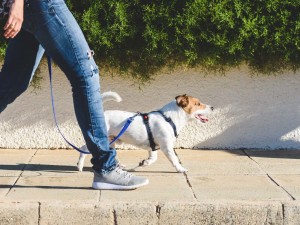I’m a Vet, and I Would Never Let My Dog Walk Like This
Here’s why this accessory is definitely not my go-to for strolls with my pup.

Share Article
My dog is excited about any outing, whether it’s a leisurely walk or a visit to the pet store. But no matter the destination, he is always secured to a harness whenever we leave the house. Don’t get me wrong: He still wears a collar that holds his rabies and identification tags at all times. Despite this, I’ll always prefer to attach his leash to his harness when it’s time to head out, not his neck collar.
I would never walk my dog on a collar instead of a harness — here’s why.
I will always opt to walk my dog with a harness. In my opinion, a harness is a safer and more comfortable option for both the leash leader and the follower. Here’s why this option gives this vet a little more peace of mind:
Harnesses have better control.
Although my dog is older and generally well-behaved, he’s not above bolting toward something he wants to investigate, even if it’s not along the intended path. He’s small but mighty, so a sudden tug can pull us both in the wrong direction. A harness gives me more control over my dog’s movements, making it easier for us to stay on track and for my dog to stay out of trouble.
They are more secure.
If a dog is being held back by a collar or harness, they may try to pull a Houdini and get out of their restraints. A dog is less likely to wriggle out of a harness that’s not an exact fit than a neck collar that’s a teeny bit loose. If you have a dog who’s kind of between sizes, a harness provides more security. Of course, you should focus on finding properly fitting items for your dog, but as anyone who has shopped for their own clothes knows, sizing can vary tremendously between brands and items.

Your dog will have reduced health risks.
If a dog has a tendency to pull or try to lead the pack and is walked by a collar, the pressure on their neck can cause trauma to their airway. Constant or abrupt pressure on the neck can be traumatic for the neck and trachea (windpipe).
I’ve actually treated a puppy that sustained a choking injury from aggressively pulling on their neck collar. Additionally, pulling on a neck collar can exacerbate any pre-existing neck pain, so dogs with a history of muscle injury or intervertebral disc disease (IVDD) in the neck can experience unnecessary pain or worsening of their condition.
They will have greater comfort from a harness.
Many dogs are happy to wear whatever gear their parents put on them, as long as they get to go for a walk. But in my opinion, pressure on the chest is far more comfortable than pressure on the neck.
Could I be convinced to walk my dog on a collar instead of a harness?
Would I ever attach my dog’s leash to his collar instead of a harness? In a pinch, sure. I have walked my dog by the collar when the distance is short, and we’re in a hurry. My dog is not used to having any pressure on his neck, and I can sense his discomfort with being walked that way, so I don’t make it a habit.
If I were to ever adopt a dog who insisted on staying by my side and maintaining my pace no matter what, I’d consider it. But my pup likes to explore at his own pace, so unless that changes, we’re sticking to a harness.
Am I secretly judging you if you’re walking your dog by its collar?
No, but I worry about you or your dog getting hurt if they’re unruly while on the leash. Large, impulsive dogs coupled with a person who can’t fully control the dog’s movements can be a recipe for accidents. Poorly controlled dogs can pull a person down, quickly ingest something that’s off limits, or approach potentially unfriendly animals.
If your dog has shown any form of aggression (even if it’s limited to specific dogs or people), you should take every precaution possible to avoid incidents. This includes making sure you have as much control over your dog’s movements as possible.
What do I suggest if you prefer to walk your dog on a collar?
If you choose to walk your dog on a collar, I would still focus on safety and comfort by keeping some of these things in mind:
Make sure the collar fits properly.
A neck collar should be snug but still loose enough for you to fit two fingers underneath. If you can’t fit two fingers underneath (or if you have to struggle to do it), the collar is too tight. If you can fit two fingers and there’s room to spare, the collar is too loose, and your dog may be able to slip out of it. Keep in mind your dog’s body shape and size.
For example, Greyhounds and Whippets have heads that are smaller than their necks, so a Martingale collar is the way to go because normal neck collars slip right off of them. In fact, Martingale collars are safer than regular neck collars overall because they distribute pressure evenly around a dog’s neck and only tighten when the pup pulls.
Choose a comfortable collar.
The material the collar is made of depends on style and personal preference. Common materials used for collars include leather, nylon, and neoprene, and all options can be comfortable if fitted properly. Make sure the collar isn’t too narrow. Skinny belts may be on trend, but skinny collars aren’t appropriate for many dogs.
The bigger the dog, the wider the collar. Skip prong or “choke” collars altogether. These rely on inducing discomfort in your dog to discourage pulling. Instead, use a comfortable collar and positive reinforcement.
Focus on training.
Work on getting your dog used to walking on a leash and following verbal cues. Train your dog to have good recall. Recall is when your dog will come to you when called, even when distractions are present. As a parent of a dog with selective hearing, this takes time and is sometimes easier said than done.
Think of a collar as something your dog can “graduate” to after they’ve been trained to stay by your side and have good recall.
Consider switching to a harness.
Walking a well-behaved dog by a collar is not inherently a cause for concern and is not something that always raises red flags for me. That being said, I would recommend switching to a harness if your dog:
Is large and difficult to control when they’re fixated on something
Is in the early stages of leash-training
Has any form of aggression
Has a history of neck pain
Has a history of tracheal collapse
Is brachycephalic (they need all the air they can get)
Whether you walk your dog using a collar or a harness is completely up to you and your dog, but for the love of everything holy, don’t use a retractable leashopens in new tab. But we’ll save that rant for another day.

Dr. Alycia Washington, DVM, MS
Alycia Washington is a small-animal emergency veterinarian with over 10 years of experience based in North Carolina. She works as a relief veterinarianopens in new tab and provides services to numerous emergency and specialty hospitals. She also works as a veterinary writer with a focus on educating pet parents.
Related articles
![Woman walking dog back into the house.]()
Does Your Dog Want Their Collar Taken off When They Get Home?
Is this like a bra or more like a necklace type of situation?
![Golden Doodle dog with Airtag collar.]()
You Can Use AirTags to Track Everything Now—Does That Include Your Pets?
The real question is: Should you?
![Woman with neck-length black hair wearing all black leather and black converse walking her brown dog on a black and white harness against a yellow tin background]()
The Best Dog Harnesses of 2025
Experts pick the best harnesses for every kind of dog—from flat-faced breeds to tiny teacups to escape artists.
![Dog walker walking with her pet on leash on the sidewalk]()
10 Tips You’ll Definitely Want to Follow When You Walk Your Dog
From the safest gear to training recs.



